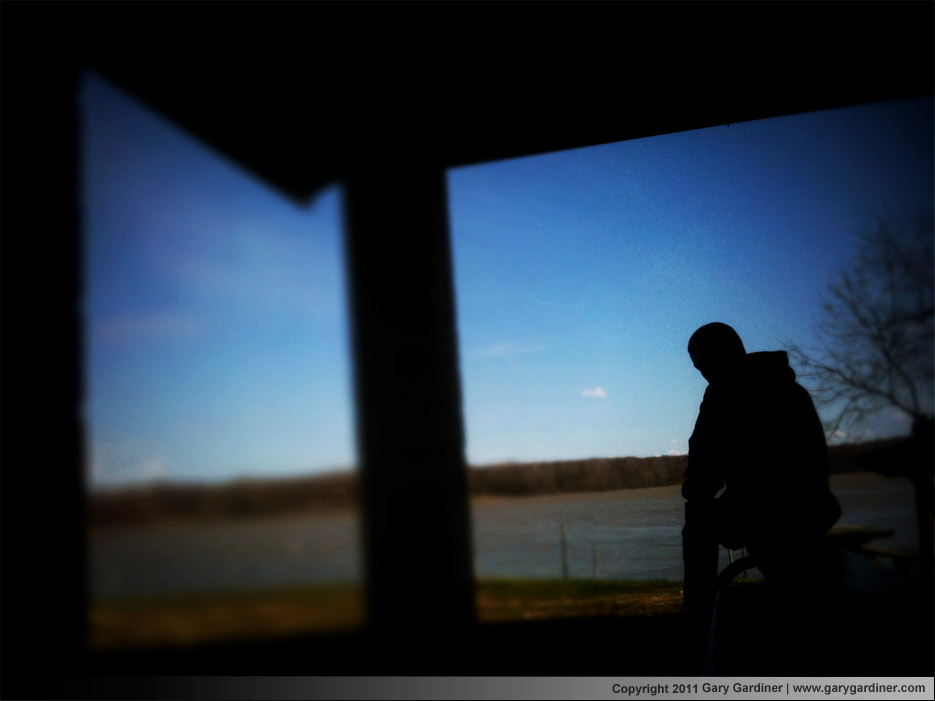Simplicity Meets Storytelling
In the Shadows
Great photography doesn’t always depend on sharp details or vivid color. Sometimes, the most stirring images are those that rely on suggestion, letting viewers fill in the blanks. In the Shadows is a perfect demonstration of this idea, using silhouette and deliberate composition to evoke a quiet, reflective mood.
At first, the picture appears almost minimal. A dark figure sits beneath a shelter’s overhang, gazing across a lake under a brilliant sky. But this apparent simplicity is exactly where the image finds its strength.
The use of a silhouette is particularly effective. By exposing for the bright sky instead of the subject, the photographer reduces the person to a pure, graphic shape. This lack of detail transforms the figure into something universal—a symbol of contemplation rather than a specific individual.
Equally important is the technique of creating a frame within the frame. The posts and beams of the shelter carve out a space inside the image, guiding the viewer’s gaze from the shadowy foreground into the luminous open air beyond. This framing adds a sense of depth and structure that makes the composition feel intentional and balanced.
The stark contrast between darkness and the bright sky heightens the emotional impact. The shadows carry a hint of melancholy, while the clear blue horizon suggests tranquility and openness. The placement of the figure—off to the right side—reinforces the sense of solitude and introspection, and the empty space to the left only underscores this feeling.
Another important touch is the soft focus around the edges, which acts almost like a natural vignette, keeping attention centered on the silhouetted figure and enhancing the dreamy, meditative atmosphere.
For photographers seeking to achieve a similar effect, the key lies in controlling exposure so that the background remains bright and the foreground becomes a silhouette. Using architectural elements or natural features as internal frames helps create layers and guide the viewer's eye. Embracing negative space can give an image room to breathe and deepen its emotional resonance.
Contrast is essential. Look for scenes where light and shadow interact in compelling ways. Simplifying your composition can be powerful—fewer details often result in a stronger, more evocative story. And finally, experiment with subtle focus shifts or vignettes to draw the viewer’s attention exactly where you want it.
In the Shadows is a reminder that a compelling photograph doesn’t need complexity. With a thoughtful approach to light, framing, and mood, you can turn an everyday moment into something lasting and profound.
Takeaways:
Expose for the Brightest Part—If you want a silhouette, meter on the sky or a bright background.
Compose with Intention—Use structural elements to create layers and depth.
Think About Story—What emotion do you want the viewer to feel? Let that guide your exposure and placement choices.
Embrace Simplicity—Fewer details can make an image more powerful.
Experiment—Try different angles and framing to see how they change the mood.
PhotoCamp Daily is not a newsletter about the technical skills required to be a good photographer or photojournalist. There are many videos, self-help books, training courses, and classes, and then there is the power of social media as an instructional tool.
PhotCamp Daily is about learning to experience making good photos and better observe subjects and their relationship to the story. Learning to express yourself better will become a collective view of your world and the new experiences you will encounter.
PhotoCamp Daily is always free! But you can pledge support at any time.
Consider subscribing to The Westerville News and My Final Photo News. Krista Steele's Into the Morning is also recommended.
My Final Photo News is a reader-supported publication. To receive new posts and support photography and commentary, consider becoming a free or paid subscriber.


